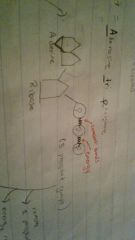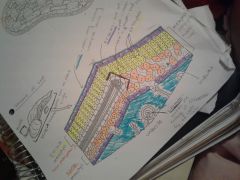![]()
![]()
![]()
Use LEFT and RIGHT arrow keys to navigate between flashcards;
Use UP and DOWN arrow keys to flip the card;
H to show hint;
A reads text to speech;
54 Cards in this Set
- Front
- Back
- 3rd side (hint)
|
What is Photosynthesis? |
The process of making glucose for food energy in plants using sunlight. |
|
|
|
Where does Photosynthesis take place? |
It occurs in the Chloroplasts. |
|
|
|
What is the Chemical Equation for Photosynthesis? The Balanced Equation? |

|
STUDY |
|
|
What is ATP? |
It is a form of energy that is used by cells. It is typically reused/recycled. The energy is stored with covalent bonds that bond all 3 phosphate groups together |
|
|
|
Where is the majority of ATP produced? |
The majority of ATP is made in the mitochondria through cellular respiration. |
|
|
|
What does ATP stand for? |
Adenosine tri phosphate |
|
|
|
What is ATP composed of? |

It is composed of Adenine, Ribose, and 3 phosphate groups that are held together by covalent bonds. |
|
|
|
What happens when you remove a phosphate group from ATP? |
Energy is released and ATP becomes ADP. |
|
|
|
What does ADP stand for? |
Adenosine di phosphate. |
|
|
|
How many phosphate groups are in ADP |
2 |
|
|
|
What happens when you add a phosphate group to ADP? |
Energy is stored and ADP becomes ATP |
|
|
|
Describe how ATP and ADP are recycled with each . Use an analogy of a rechargeable battery to support your answer. |
ATP and ADP are recycled with each other like a rechargeable battery because ATP is made up of 3 phosphate groups that act as energy and whenever you remove a phosphate group you release energy and thus create ADP. This is similar to the way that you use the energy in a rechargeable battery for your own purposes and as you keep using that energy, the once fully charged battery becomes a battery with less energy. Once you are done using that energy, you can charge it so that energy could be stored and you could have a fully charged battery. This is similar to the way how you add phosphate group to ADP to store energy and thus create ATP. The cycle then continues |
|
|
|
What role do pigments play in the process of photosynthesis? |
Pigments are needed for photosynthesis because they gather sunlight to make energy. Pigments such as chlorophyll absorb light to make into energy. They are molecules |
|
|
|
Where is chlorophyll located? |
It is located in the thylakoid. |
|
|
|
What types of light are reflected by pigments? Absorbed? |
Colors such as violet, blue, orange, and red are absorbed whereas colors such as green and yellow are reflected. |
|
|
|
What types of light are reflected by pigments? Absorbed? |
Colors such as violet, blue, orange, and red are absorbed whereas colors such as green and yellow are reflected. |
|
|
|
What is an electron carrier? |
It is a molecule that carries high energy electrons. |
|
|
|
What is the role of NADPH in photosynthesis? |
NADPH carrier the high-energy electrons that were produced by light absorption in the chlorophyll to chemical reactions elsewhere in the cell. It has 2 electrons. |
|
|
|
What is the role of NADP+ in Photosynthesis? |
One of the carrier molecules that transfers high-energy electrons from chlorophyll to other molecules. It only has 1 electron. |
|
|
|
What happens when you add an electron to NADP+? |
You form a bond and create NADPH |
|
|
|
What happens when you take out an electron from NADPH? |
You break the bond and create NADP+ |
|
|
|
Draw a diagram of a chloroplast and label the following parts: stroma, granum, thylakoid, outer membrane, inner membrane. |

|
|
|
|
What is the stroma? |
It is the cytoplasm in the chloroplast. |
|
|
|
Where do light reactions take place? |
In the Thylakoid. |
|
|
|
Where do dark reactions take place? |
In the stroma. |
|
|
|
How do the reactants and products enter/leave the leaf?
|
A leaf usually has a large surface area, so that it can absorb a lot of light. The upper part of the leaf is where the light falls, and it contains a type of cell called a palisade cell. This is adapted to absorb a lot of light. It has lots of chloroplasts. Water is absorbed through the xylem which is located inside the vein. The vein has a big surface area and thin walls that allow water to pass through them easily. The carbon dioxide diffuses through small holes in the underside of the leaf called stomata. The stomata controls the exchange of CO2 and O2 and water vapor. |
|
|
|
What does water produce? |
Water produces H+ ions and splits electrons. Oxygen is released as a byproduct. |
|
|
|
How do the light dependent reactions rely on the light independent reactions? |
Light-dependent reactions use energy from sunlight to produce oxygen gas and convert ADP and NADP+ from the light-independent reactions into energy carriers such as ATP and NADPH. |
|
|
|
How do the light independent reactions rely on the light dependent reactions? |
Light independent reactions use electron carriers such as ATP and NADPH produced in the light-dependent reaction to produce high-energy sugars such as glucose from carbon dioxide. |
|
|
|
In what set of reactions--light independent or light dependent-- does each reactant of photosynthesis enter? |
In light-dependent reactions, sunlight energy, and water enter. This set of reactions creates the byproduct of oxygen and electron carriers such as ATP and NADPH. In light-independent reactions, carbon dioxide enters and produces glucose through the provided energy of ATP and NADPH. ADP and NADP+ are the end products of this reaction and are cycled back for reuse in the light-dependent reactions |
|
|
|
What is the Calvin Cycle? |
In the most general sense, the primary function of the Calvin cycle is to make organic products plants need, using the products from the Light Reactions of photosynthesis (ATP and NADPH), These products include glucose, the sugar made using carbon dioxide and water |
|
|
|
Structure of Leaf: What is the cuticle ? |
It is a clear, waxy coating and waterproof barrier. |
|
|
|
Structure of Leaf: What is the use of the blade in a leaf? |
It increases the surface area to absorb more sunlight. |
|
|
|
Structure of Leaf: What is the epidermis? |
It is a thick cell wall that protects. |
|
|
|
Structure of Leaf: The Vein is consisted of what? |
The Xylem that transports water and the Phloem that transports food (glucose) |
|
|
|
Structure of Leaf: Where does most photosynthesis occur? |
In the mesophyll |
|
|
|
Structure of Leaf: What does the Stomata do? |
It controls the exchange of CO2, O2, and water vapor. |
|
|
|
Draw the structure of a leaf |

|
|
|
|
What is Cellular Respiration? |
It is the process that releases energy in food to produce ATP. This happens in the mitochondria in the presence of oxygen. It is an aerobic reaction. |
|
|
|
What does Anarobic mean? |
No oxygen is required. |
|
|
|
What does Aerobic mean? |
Oxygen is required. |
|
|
|
What is the chemical equation for cellular respiration? |
Oxygen +Glucose -> Carbon Dioxide+ ATP+ Water 6O2 + C6_H12_O6 --> 6CO2 + ATP + 6H2O |
|
|
|
What is a matrix? |
It is the cytoplasm in the mitochondria. |
|
|
|
Why do macromolecules differ in the amount of energy they contain? |
The energy stored in each of these macromolecules varies because their chemical structures, and therefore their energy-storing bonds, differ. |
|
|
|
How is the chemical energy in glucose similar to money in a savings account? |
The chemical energy of glucose is stored in the body as (ATP), whenever this energy is needed. It can be directly taken and consumed by the body. In savings account it's the same idea, you save your money there, and anytime you need money you can take it from your account directly without waiting and spend it. |
|
|
|
Why do all organisms need food? |
Food provides organisms with the energy they need to carry out life processes such as growth and reproduction. |
|
|
|
What are the 3 steps of Cellular Respiration? |
1. Glycolysis 2. Krebs Cycle 3. Electron Transport Chain |
|
|
|
What happens during Glycolysis? |
One glucose molecule is broken down into two molecules of pyruvic acid (pyruvate) in the cytoplasm. In the process of creating two pyruvates, two molecules of ATP are created. NAD+ becomes NADH and ADP becomes ATP. Both of these products are electron carriers. Glycolysis takes place outside the mitochondria and it is anaerobic meaning that it requires no oxygen. |
|
|
|
What happens during the Krebs Cycle? |
The Krebs cycle uses the two molecules of pyruvic acid formed in glycolysis and yields high-energy molecules of NADH and FADH2, as well as some ATP. It also creates some carbon dioxide which is released as a waste product. The Krebs Cycle is aerobic meaning that it requires oxygen, it happens in the matrix of the mitochondria. |
|
|
|
What happens during the Electron Transport Chain? |
The electron transport chain uses the high-energy electrons from Glycolysis and the Krebs Cycle to convert ADP to ATP. Oxygen serves as the final electron acceptor of the electron transportation chain. At the end of the electron transport chain is an enzyme that combines these electrons with hydrogen ions and oxygen to form water. ATP is also created. A total of 32 ATPs are created by the Electron Transport Chain itself. |
|
|
|
At the end of cellular respiration, how many ATPs were produced? |
36 |
|
|
|
In what ways are cellular respiration and photosynthesis considered opposite processes? |
Photosynthesis "deposits" energy, and uses carbon dioxide and water, and produces oxygen and glucose. By contrast, cellular respiration "withdraws" energy, uses oxygen and glucose, and produces carbon dioxide and water. Photosynthesis removes carbon dioxide from the atmosphere, and cellular respiration puts it back. Additionally, reversed. The reaction for cellular respiration: C₆H₁₂O₆ + 6O₂ → 6CO₂ + 6H₂O The chemical reaction for photosynthesis is: 6CO₂ + 6H₂O → C₆H₁₂O₆ + 6O₂ |
|
|
|
What is Fermentation? |
It is when energy is released from food to make ATP in the absence of oxygen. This process is anaerobic. |
|
|
|
What happens during Fermentation? |
During Fermentation, one of the two things happen: NADH becomes NAD+ and lactic acid is produced. This type of fermentation is called Lactic Acid Fermentation. This acid can be found on the muscles of humans. It usually creates pain and when used on food, it creates a sour flavor due to the microbes present. OR NADH becomes NAD+ and CO2 is also produced. In the end, Ethyl Alcohol is produced. This type of fermentation is called Alcoholic Fermentation. This fermentation is controlled by microbes. |
|

